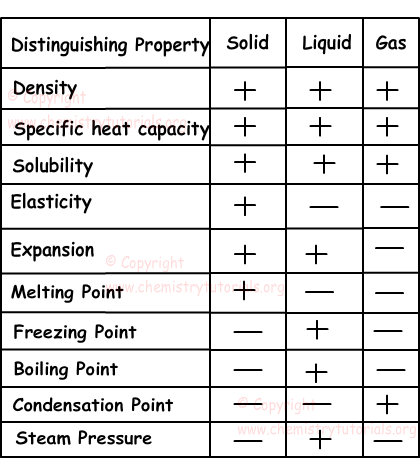Matters and Properties of Matters Cheatsheet
Matters and Properties of Matters Cheat Sheet
Matters
Everything having mass and volume is called matter , such as air, table, water.
Physical Change:
In this type of changes, there are no permanent changes in the structure of matters. Physical appearance of the matters are changed.
Chemical Changes:
In chemical changes, both physical appearance and structure of matters are changed and new matters are formed. For example, burning paper, rusting of an iron, photosynthesis. For example, melting of ice, breaking glass.
Physical Properties of Matters:
Physical properties can be measured without changing the structure of matters. Color, melting, freezing, boiling points, density, specific heat capacity of matters are examples of physical properties of matter.
Chemical properties of Matters:
Chemical changes in the matter shows us chemical properties of matter. For example, rusting of iron is chemical properties of matter.
Table given below shows common and distinguishing properties of matters;

Density: Density is the mass of unit volume. It is represented by letter “d”. We find density with following formula;
d=m/V where m is the mass and V is the volume of matters.
Solubility: It is the capability of matter dissolve in solvent. For example, sugar dissolves in water.
1) Pure Matter: Same types of atoms or molecules comprise pure matters.Iron, alcohol, salt are examples of pure matters.
- They are homogeneous.
- They have specific physical properties like boiling point, density or freezing point.
- Temperature during phase change is constant
a) Elements: Element is the simplest matter which contains one type of atom. There are 109 known element in nature. We show elements with symbols like for iron we use “Fe”.
b) Compounds: Two or more than two elements come together in specific amounts and form new matter that we call compound. Properties of compounds are totally different from elements comprising it.“NaCl”, “H2O are examples of compounds.
2) Mixture: Different two or more than two types of matter (element, molecule, compound) are mixed to get mixture. All matters forming mixture keep their original properties. They are not pure matters.Homogeneous mixtures and heterogeneous mixtures are two types of mixture.
Emulsion, Suspension and Colloids are types of mixtures.
Decompositions of Compounds and Mixtures
Decompositions by Electrification, Decompositions by Magnetization, Decompositions by Filtering, Decompositions by Using Density Differences of Matters, Decomposition by Using Solubility Differences of Matters, Decomposition by Using Boiling Points of Matters, are some common decomposition methods for mixtures.
In decompositions of compounds, chemical methods are used.
a) Decomposition of Compound by Heat:
Heat can decompose compounds into another compounds or its elements.
b) Decomposition of Compounds by Electrolysis:
Electrolysis is a method in which, compound mixed with liquid and two metal rod placed into this mixture. Electric current is applied to this mixture and make compound decompose its elements.
Matters can exist in four states; solid, liquid, gas and plasma.
Melting: Solid matter changes its state to liquid.
Freezing: Opposite process of melting is called freezing. Liquid matter loses heat and changes its state to solid.
Boiling: Liquid matters gain heat and change their states to gas.
Condensation: Opposite process of boiling is called condensation. Gas molecules lose heat and change its phase to liquid.
Properties and Naming Simple Compound with Examples
a) Nonmetal+Oxygen Compounds:
We first say name of nonmetal element then number of oxygen atoms in the compound and word “oxide”. For example;
I. CO: Carbon Monoxide (one carbon atom and one oxygen atom)
b) Metal+Oxygen Compounds:
Naming these compounds are different from naming nonmetal+oxygen compounds. Prefixes given above are not used in naming these compounds. On the contrary, oxidation number of metals are given in these compounds if necessary. Better understanding examine following examples;
CaO: Calcium Oxide (Since calcium has one oxidation number +2, we do not write it.)
Cu2O :Copper I Oxide
CuO: Copper II Oxide (Since copper has two oxidation number we write them.)
c) Nonmetal+ Nonmetal Compounds:
In these types of compounds, you must first write element having “+” oxidation number and then “-” number of atoms in second nonmetal element or more metallic element is written first. You must also add “ide” suffix after second element.
CS2: Carbon disulphide
d) Metal+Nonmetal Compounds:
In naming metal+nonmetal compounds, we do not say number of atoms in elements, however, we must say oxidation number of elements if it has more than one oxidation number. Finally, as in the previous examples, we must ad “ide” suffix after second element.
MgI2: Magnesium Iodide
e) Naming Binary Acids:
If a binary compound dissolves in water and contains H atom, we call these compounds as acid. When naming these acids we follow given steps. Hydro+nonmetal element+“ic” suffix+ acid.
HCl: Hydrochloric acid
Matters and Properties of Matters Exams and Problem Solutions